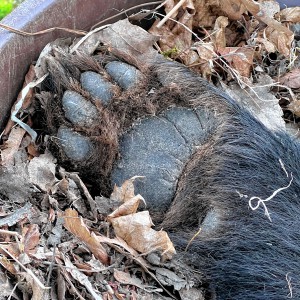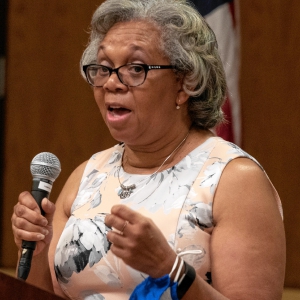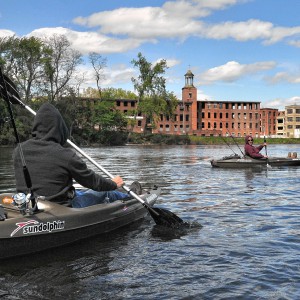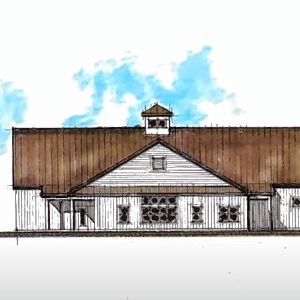Choice cuts: Sutter Meats’ butcher shows how to make every piece of pork count
| Published: 04-21-2017 3:10 PM |
Terry Ragasa, co-owner of Sutter Meats in Northampton, is all business when it comes to turning a pig fresh from the farm into primal cuts of raw culinary material.
Between a wrinkle here and a pocket there, Ragasa has all the tricks to locate each cut. He pares down the animal with the graceful ease of a man who’s done this a thousand times. Because he probably has.
“It’s become a muscle memory sort of thing,” he says. “You start to understand the animal.”
Each month, Ragasa shares his tricks with anyone who signs up to listen and watch. The two-hour class costs $100, and it’s for “anybody who wants to learn more about where their food is coming from,” says Ragasa.
The next ones are scheduled for May 6 and May 20.
During one class on a recent Saturday, Ragasa dismantles a pig from Sage Farm in Montague, starting at the top.
He cuts off the head.
“Pigs don’t really have necks like we do so that is tender meat in that area,” he adds pointing it out with his blade. “People don’t typically eat the pork brains,” he says. “At least not around here.”
Article continues after...
Yesterday's Most Read Articles
 Holyoke man finds bear paw in his yard
Holyoke man finds bear paw in his yard
 Petition to block auto dealership on King Street falters in Northampton
Petition to block auto dealership on King Street falters in Northampton
 First look at how little Amherst’s police alternative being used called troubling
First look at how little Amherst’s police alternative being used called troubling
 Developer lands $400K loan for affordable housing project in Easthampton mill district
Developer lands $400K loan for affordable housing project in Easthampton mill district
 Developer pitches new commercial building on Route 9 in Hadley
Developer pitches new commercial building on Route 9 in Hadley
 Boyfriend accused in slaying of Hampden sheriff’s assistant, former legislator’s top aide
Boyfriend accused in slaying of Hampden sheriff’s assistant, former legislator’s top aide
But that doesn’t mean the head gets ignored. In fact, he says, there’s enough facial marbling that it makes for a fine coppa di testa — a terrine made from the whole head of an animal.
The head also yields jowl meat, which means, in a word: guanciale.
“As you can see,” he says, pointing to the cheek. “It’s fatty — fattier than belly bacon.”
Guanciale is Italian-cured pork, similar to bacon.
“I tell people to use it more as a flavoring agent,” he says.
Even meat from around the eyes goes to good use in a broth as it adds richness and helps with digestion. And, he says, it makes for an especially tasty ramen broth.
For Ragasa, each cut is the means to a culinary end.
In Northampton, Ragasa says, there’s a steady stream of dog lovers coming through the doors, and so he usually saves the ears and tails, tossing them in the smoker for dog treats.
Pork butt, he says, makes the best sausage.
“The butt is really good for sausage because it already has the ideal fat-to-lean ratio. It’s great for pulled pork, too.”
And meat from the neck makes for a mean tomato sauce.
“It adds such a wonderful richness,” he says. “We had a couple who would buy all of our neck bones just for the meat in between the bones.”
Moving away from the head, Ragasa outlines the major portions remaining — shoulder, loin, belly and ham.
Pork butts, from the shoulder of the animal, are called “butts” likely because that’s the name for large barrels that used to contain those cuts during colonial times, he says. The ham is the rear leg section of the animal typically reserved for special occasions, he says. When people refer to “fresh ham,” they’re referring to the rear leg.
Ragasa slows the process down a tad for our benefit, separating the animal at the muscular seams during the class.
Muscles lighter in color with looser grain, he points out, signal a more tender cut. It’s also a way to distinguish between farm-raised animals and those raised in captivity, which move less and therefore have less blood moving through their muscles. The muscles in captive animals are all the same light color — “no blood, no flavor,” he says.
Meat that comes from captive animals looks less appealing in a display case. He says it has no muscle tone.
“It’s something that doesn’t look very good, if the pork is just sitting there all flaccid.”
Ragasa turns his attention back to the fresh animal at hand.
“Our pigs are the opposite of that,” he says. “This whole pig — all the muscles are dark in color.”
Counting six ribs back, he points to the loin. Then there’s the famed belly section, which yields the all-American favorite: bacon.
“Belly meat is mostly used for bacon, but it’s also a good roasting cut,” Ragasa says.
Loosening the flank section, he sheers off a layer of what he calls “leaf fat.”
“It’s the best fat for baking because there’s no water in it,” he says, adding that it bakes off with a “flaky” texture.
Once rendered, he says, leaf fat “makes the most beautiful cooking fat.”
Toward the rump, Ragasa locates the sirloin. “Sirloin tips” also has an additional meaning — anything cut against the grain and marinated.
He debones the sirloin, leaving a hearty hunk of glistening meat.
“This is good for pulled pork,” Ragasa says, looking down at his prize. “I find this one of my favorite cuts to eat as a steak, too.”
He calls the sirloin the “unsung hero” of the pig. So few places do whole-animal butchery anymore that knowledge of other choice cuts like this one has dwindled, he says.
You’ll find the tenderloin tucked underneath the hip bone, he gestures. “It’s super tender because it doesn’t do much work.” This cut, he says, is great for chateaubriand and filet mignon.
Butter flying the surrounding meat, he opens up the rear leg “like a little book” and removes the ham bone, exposing the eye of the round. The top round, he points out, is lean and so is good for cutlets and schnitzel.
“You can feed a party with one of these,” he says.
To remove the shoulder from the loin, he counts five ribs back from the shoulder side of the chop, which is the fattier side. This reveals the baby back ribs and spare ribs, which he says are essentially the same. Contrary to marketing power, baby back ribs are not more tender because they’re closer to the loin. In both cases, he says, “you’re eating the meat between the bones.”
Now, as the days get warmer and longer Ragasa says he’s ready for the best time of the year. Barbecuing season is here, he notes. “Sirloin chops and pork chops make for really nice cuts on the grill.”
Class details
Pork Fabrication is a two-hour interactive demonstration with Sutter Meats co-owner Terry Ragasa.
It will be offered May 6 and 20 and June 3 and 17 from 1 to 3 p.m. The cost is $100 per class.
Ragasa will breakdown one side of a locally raised pig, field questions, identify and discuss the attributes of each cut of meat and give pointers on how to best prepare them.
In addition to instruction on seam butchery technique and whole muscle utilization, each student will take home a supply of mixed pork cuts. The class is limited to six students.
For reservations, call the store a 727-3409.
Amanda Drane can be reached at adrane@gazettenet.com.
]]>

 Valley Bounty: Grass-fed animals that feed the grass: Gwydyr Farm in Southampton focuses on ‘restoring the connection between land, food and people’
Valley Bounty: Grass-fed animals that feed the grass: Gwydyr Farm in Southampton focuses on ‘restoring the connection between land, food and people’ Weekly Food Photo Contest: This week’s winner: Mary Chicoine of Easthampton
Weekly Food Photo Contest: This week’s winner: Mary Chicoine of Easthampton  Speaking of Nature: A romantic evening for two birders — To hear the wonderful sounds of the Saw-whet Owl one must go outside at night
Speaking of Nature: A romantic evening for two birders — To hear the wonderful sounds of the Saw-whet Owl one must go outside at night Speaking of Nature: Where have all the birds gone?: They’re there, and here’s a handy tool to keep track of their appearances
Speaking of Nature: Where have all the birds gone?: They’re there, and here’s a handy tool to keep track of their appearances
